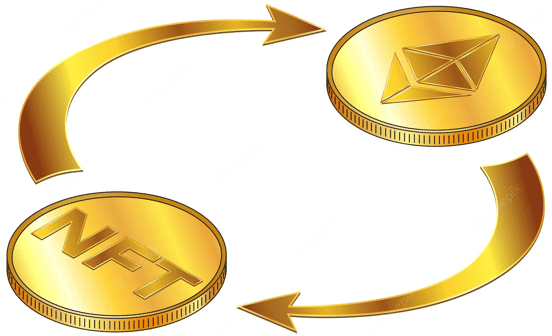
NFTs (Non-Fungible Tokens) are very popular today and they act as proof of ownership of pieces of digital art. NFTs have also been adopted in a wide variety of industries. A good number of celebrities have jumped into the NFT bandwagon as NFTs are expected to change the entertainment industry. The gaming industry has also not been left out as it is now possible to make money in the form of NFTs by playing games. This comes after the launch of many play-to-earn (P2E) NFT games.
Most NFTs run on the Ethereum blockchain network. ETH is the native cryptocurrency of the blockchain, but the NFTs run on the Ethereum blockchain. NFTs have additional information that makes them function differently from cryptocurrencies such as Bitcoin and Ethereum. There are also many NFT Ethereum platforms that allow you to mint, buy, and sell NFTs.
Ethereum leads other blockchain networks and NFTs were invented on the Ethereum blockchain. The Ethereum blockchain network has a secure data architecture and network, and that is why it leads the decentralized finance (DeFi) market. The NFT Ethereum projects run on the network as ERC-721 tokens. The Ethereum blockchain also exposes NFTs to a large and growing NFT market.
It is recommended that NFT Ethereum projects should maintain their compatibility with the Ethereum virtual machine to be supported by Ethereum wallets such as MetaMask. They will also be acceptable on Ethereum NFT marketplace platforms.
Related :
However, NFT Ethereum projects are not immune to challenges. For instance, NFT Ethereum projects experience a high volume of network traffic causing a slow transaction speed. As a result, NFT Ethereum users incur high transaction fees. Some of the common Ethereum NFT marketplace platforms include OpenSea, Nifty Gateway, and Rarible.
As a result of the limitations experienced by NFT Ethereum collectors, a significant number of NFT users have turned to alternative blockchain networks. Currently, Solana is seen as the best blockchain network alternative to Ethereum for minting and trading NFTs. It is cheaper to mint NFTs on the Solana blockchain. It is also faster than the Ethereum blockchain. Polygon is also another alternative to the Ethereum blockchain for minting NFTs.
Do I need Ethereum to Buy NFT?
This is a common question among many NFT beginners.
Other NFT beginners also ask:
Can you buy NFT with Ethereum?
Can I buy NFT with Kovan Ethereum?
We will be answering such questions in this section.
NFTs are bought on NFT marketplaces using cryptocurrencies. This means that one needs a cryptocurrency wallet to store the crypto coins for buying the NFT of choice. The crypto wallet must also be connected to the NFT marketplace from which to buy NFT.
NFT marketplaces run on different blockchain networks, some on the Ethereum blockchain network, others on the Solana Blockchain, and more. Each NFT marketplace requires payment to be made in the native token of the blockchain network on which it operates. Thus, if an NFT marketplace runs on the Ethereum blockchain, it will require you to pay using ETH. If the NFT marketplace runs on the Solana blockchain, it will require you to pay with SOL.
Thus, to the question:
Do I need Ethereum to Buy NFT?
The answer is “no.” It all depends on the NFT marketplace from which you want to buy the NFT. If you don’t have the native cryptocurrency of the NFT marketplace in your wallet, you can buy it from a cryptocurrency exchange platform such as Binance, Coinbase, or CoinMarketCap. You can then transfer it to the crypto wallet linked to the NFT marketplace. MetaMask is the best Ethereum wallet for NFT.
Polygon vs Ethereum NFT
Other than the Solana blockchain network, Polygon is another alternative to the Ethereum blockchain network for minting and trading NFTs.
Polygon is a Layer 2 or side chain solution to ETH, allowing you to deploy your Ethereum smart contracts. However, you deploy the smart contracts to the Polygon network rather than to the ETH.
Thus, Ethereum is the main chain while Polygon is the side chain. There is a bridge that exists between the Ethereum and Polygon chains. The bridge makes it possible to convert assets from one chain to another, a process that involves locking the asset in one chain and unlocking it on the other chain.
Gas fees are an important factor to consider when comparing Polygon vs Ethereum NFTs. The good news is that you won’t incur insane gas fees for minting an NFT on the Polygon blockchain. There are no direct gas fees for using Polygon on the OpenSea Ethereum NFTs marketplace. However, when buying NFT on the Polygon blockchain, you will indirectly incur gas fees charges since Polygon blockchain NFTs can only be bought via Polygon ETH.
You can get the Polygon ETH by bridging ETH over to Polygon and you will incur gas fees charges for this. So, you will incur cheaper gas fees charges on Polygon.
On the other hand, NFT collectors incur huge gas fees for minting NFTs Ethereum. This makes it unsuitable for NFT collectors with small portfolios.
Read Also :
